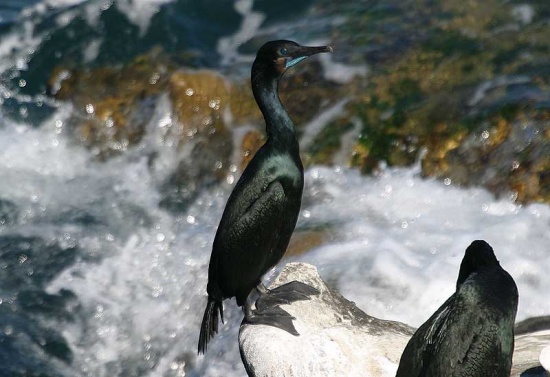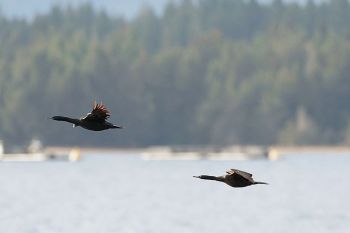- Urile penicillatus
Phalacrocorax penicillatus
Identification
27.6-31.1 in (70-79 cm)
- Black body
- White plumes on neck and back in breeding season
- Pale tan throat framing to blue throat patch during breeding season
- Long, hooked bill
- Medium length tail
Juvenile: brownish-black with pale brown blaze across chest.
Similar Species
Pelagic Cormorant is smaller with thinner bill, thinner neck, smaller head and longer tail. In breeding season Pelagic has dark crest and white flank patches.
Distribution
Pacific coast of North America from southern Alaska to Baja California.
Taxonomy
This is a monotypic species[1].
Habitat
Open sea, rocky islands for breeding.
Behaviour
Diet
The diet includes fish.
Breeding
Nests are large and untidy, made of terrestrial plants or seaweed, placed on the ground or on rocky outcrops.
References
- Clements, J. F., P. C. Rasmussen, T. S. Schulenberg, M. J. Iliff, T. A. Fredericks, J. A. Gerbracht, D. Lepage, A. Spencer, S. M. Billerman, B. L. Sullivan, M. Smith, and C. L. Wood. 2024. The eBird/Clements checklist of Birds of the World: v2024. Downloaded from https://www.birds.cornell.edu/clementschecklist/download/
- Information from the All About Birds website, https://www.allaboutbirds.org/, © Cornell Lab of Ornithology.
Recommended Citation
- BirdForum Opus contributors. (2025) Brandt's Cormorant. In: BirdForum, the forum for wild birds and birding. Retrieved 18 May 2025 from https://www.birdforum.net/opus/Brandt%27s_Cormorant
External Links
GSearch checked for 2020 platform.1.







